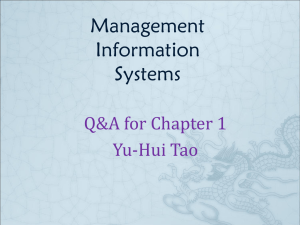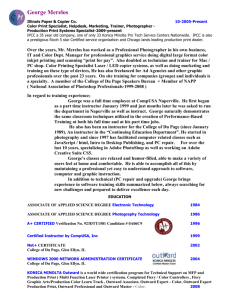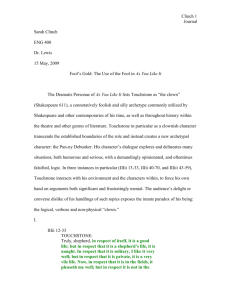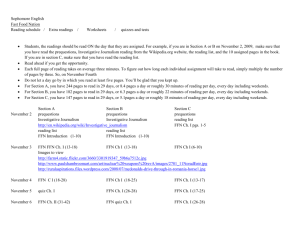Introduction to United Way Business Model
advertisement
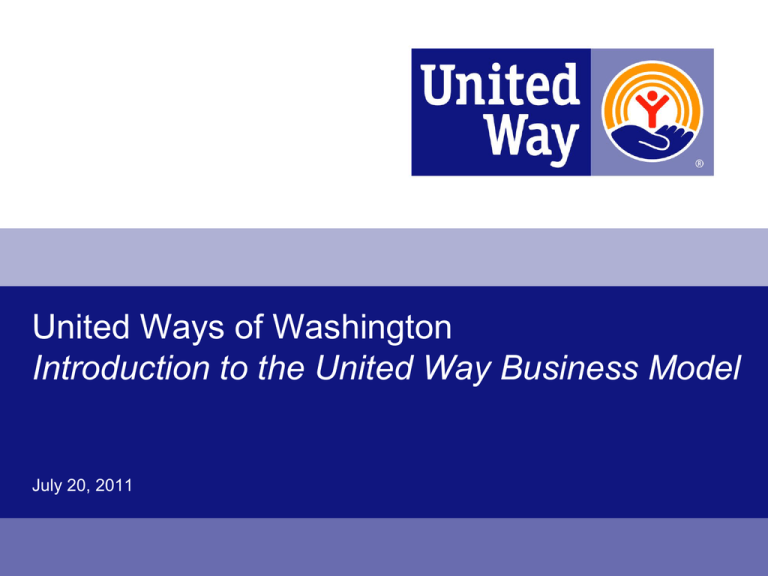
United Ways of Washington Introduction to the United Way Business Model July 20, 2011 Agenda • Community aspirations, challenges and the role of the United Way • Work of the traditional UW and the need for change • United Way Business Model • Discussion 2 Why We Exist and the Value We Add Mission To improve lives by mobilizing the caring power of communities around the world to advance the common good. Value Proposition We galvanize and connect a diverse set of individuals and institutions, and mobilize resources, to create long-term change. 3 Our environment We face internal and external challenges • We’re losing donors • Companies moving to “strategic philanthropy” approach • Overreliance on old economy business • There is a large trust gap across age groups • We have low public trust compared to other large nonprofits But we also have real assets • Strong brand • Large footprint • We can and do bring people together • Millions of supporters 4 What does this all mean? • We are going to have to work very differently, building on our assets • We have to do this with our communities • Figure out what makes a difference, bring folks together to get it done, and raise money to do it • We’ve always been an intermediary and we still are, but we have to add value 5 United Way Business Model What will it take to become a United Way mobilizing for community impact? A deeper focus on certain elements of the Standards of Excellence Engage and align with the community Create & deepen relationships with individuals & institutions Develop strategies and focus actions Mobilize resources Align and execute on plans and strategies Measure, evaluate & communicate results If we wish to be effective, we will need to: Operate as an integrated and aligned organization Have the right skills, competencies & leadership 6 Engage and align with the community What it means: • Working with stakeholders to set community-wide goals and priorities What United Way does: • Builds community knowledge through conversations • Builds coalitions of multi-sector partnerships • Communicates how people’s input is making a difference • Identifies people wanting to do more – the “hand raisers” What needs to change: • Base United Way decisions on community priorities • Listen first, and not just once 7 Create & deepen relationships with individuals & institutions What it means: • Understanding and deepen relationships with individuals and institutions aligned around long-term community goals What United Way does: • Puts processes in place to make relationships work • Collects data on supporters and uses it • Uses technology to track relationship interactions What needs to change: • Expand beyond institutional focus to include individual focus • Building and managing relationships becomes a core competency 8 Develop strategies and focus actions What it means: • Using community and expert knowledge to set bold community goals and build strategies with community partners that get at the root causes of education, income, and health challenges What United Way does with partners: • Sets meaningful community goals • Builds action plans • Gets agreement on which partners will play what role What needs to change: • Strategies are community-wide, comprehensive strategies, not United Way strategies • Strategies have to get at root causes – we can’t direct service our way into social change 9 Mobilize resources What it means: • Identifying what it will take to get to your results and giving donors, volunteers, and advocates a chance to support the work What United Way does: • Identifies the resource needs of the community change strategies • Develops multi-year plans to mobilize resources • Gives supporters things to do that will lead to results –GAV What needs to change: • Create ways for people to do more than just give, especially in the workplace • Generate resources aligned to results • Money is not the only resource that matters in social change 10 Align and execute on plans and strategies What it means: • Aligning United Way activities and resources to deliver on our roles in community change efforts; implementing community strategies; and sharing accountability What United Way does: • Aligns operations and processes to support community strategies • Execute in a cross-functionally aligned manner What needs to change: • Integrated execution replaces siloed behavior • Creating community change is long-term with interim metrics of progress 11 Measure, evaluate & communicate results What it means: • Evaluating results of the community change strategies, adjusting them, and sharing successes What United Way does: • Sets up a system of ongoing data collection and review • Shares stories of progress to build public will • Adjusts strategies as needed What needs to change: • Measure in populations improved, not just clients served • Use storytelling to connect your efforts to the larger change over time • United Way doesn’t take the credit-celebrate partners 12 How we execute against the Business Model • Work on things that matter to people • Connect with more people - get them involved • Get agreement on strategies • Give everyone a chance to support the plan • Tell people about the results 13 Some implications for our work • New skills – change management leadership, grassroots organizing, issues management, strategic communications, advocacy, relationship management, social media • New content expertise – education, income, and health • Executing according to value proposition – conveners, “mobilizers”, “aligners” of efforts towards long-term community change • Diversification of revenue streams – complex grants (federal, state, and private), individual gifts, etc. • Technology – new platforms to enable individual giving, advocacy, and volunteering; new relationship management tools; back office/financial systems for a new era • Full organizational alignment – functional teams must work seamlessly • Network alignment – we must operate as a truly interdependent network that coordinates appropriately 14 Small size not necessarily a disadvantage Smaller size often provides: • Greater agility • Quicker buy-in • Greater reliance on community resources • Closer relationship with stakeholders 15 Discussion What are your reactions to the Business Model? How would your board and your community respond to these ideas? What are the opportunities in your community to implement some of these business practices? 16 Thank You 17 United Ways of Washington Executing on the Business Model July 20, 2011 18 Session Purpose Share effective approaches and practices that help United Ways become more relevant in their communities as well as increase revenue and the number of donors. 19 Agenda Executing on the business model Touchstones for executing on the business framework • Turn Outward • Build deep, meaningful, ongoing relationships • Go beyond funding services to true Impact Strategies • Connect investors to strategies • Measuring success Discussion 20 Our Response to Changes in Our Environment If we’re going to add value in communities, we have to: Galvanize and connect a diverse set of individuals and institutions, and mobilize resources, to create long-term change. • • • • • Listen to what the community cares about Figure out what’s going to make a difference Raise money and bring supporters together Get it done – with your partners Talk about your progress, the role you play, and adjust when you need to 21 United Way Business Model ENGAGE WITH COMMUNITY MEASURE AND COMMUNICATE BUILD STRATEGIES EXECUTE GATHER RESOURCES 22 Execution to what end? Brand positioning and promise Pillars or Focus areas Target issues Intended results Indicators Advancing the common good by creating opportunities for a good life for all Education Income Health Helping children and youth achieve their potential Promoting financial stability and independence Improving people’s health e.g., academic achievement e.g., Young people graduate from high school e.g., Public on-time high school graduation rate* *As measured by the averaged freshman graduation rate 23 Touchstones for Executing on the Business Framework 1. Turn Outward 2. Build deep, meaningful, ongoing relationships 3. Go beyond funding services to true Impact strategies 4. Connect investors to strategies 5. Measuring success 24 Touchstone 1: Turn Outward • The act of seeing and hearing those in the community and acting with intentionality to create change. • A reorientation toward the public. 25 Turn Outward: The Quiz 1. Complete the Turn Outward Quiz individually 2. Within your group, compare observations 3. Identify three benefits of turning outward 4. Identify three concerns 26 Touchstone 2: Build deep, meaningful, ongoing relationships • Relationship Management (RM) is an organizational strategy to put the constituent at the center of everything we do. • The goal of relationship management is to better understand, relate to and engage a constituent to (a) improve their experience with our brand and (b) generate longer-standing and more significant relationships with them. 27 Touchstone 2: Build deep, meaningful, ongoing relationships • Relationship management success is contingent on everyone in the organization, from the CEO to each and every staff and Board member and volunteer, buying into and supporting the effort. • Requires shifting the organization’s mindset to center on relationships rather than transactions. Relationship management is a way of doing business across the organization that tailors the constituent experience in order to forge lasting relationships. 28 Touchstone 2: Build deep, meaningful, ongoing relationships Build more personal and relevant connections with current and prospective individuals so that… they become inspired to sign on for the cause and commit to act on the impact work and/or with United Way. 29 Touchstone 3: Go beyond funding services to true Impact Strategies program clients program clients program clients program clients program clients program clients program clients program clients program clients program clients 30 Many Factors Contribute to Pressing Community Issues Economic conditions Public attitudes Historical trends Media messages Public sector policies/ practices Private sector policies/ practices Health care system policies/ practices Education system policies/ practices System relationships Neighborhood conditions Personal choices Family dynamics 31 Changing community conditions Schools, NGOs, Hospitals, Businesses, Churches and Civic Groups Systems Areas Surrounding Homes, Workplaces, Schools, and Service Providers Community population Government Agencies, Health Care Systems, the Media, and the School System Friends, Family, Neighbors, Other Close Associates 32 Example TARGET OUTCOME: Children from families earning under 125% poverty receive appropriate vaccinations before entering school 33 Example PROBLEM: Clinic is opened when caregivers are working Clinics begin operating during evening hours to accommodate working parents PROBLEM: Vaccines aren’t accessible for people Schools and public health systems begin integrating their services so that caregivers can access them in one location Systems PROBLEM: Can’t locate clinics Signs are put up alerting people to the location of local children’s clinics Children from families earning under 125% poverty PROBLEM: Caregivers don’t know vaccines are important: Caregivers take their children to the doctor to receive vaccinations 34 Examples of Changes in Community Conditions that can Benefit Populations Target outcome Single mothers not taking advantage of public and employer benefits begin to use those benefits to increase their incomes Supporting changes in community conditions • in organizations Employers adopt opt-out policies for benefits that increase employee income • in systems Public benefit programs adopt uniform eligibility requirements and applications, 1-visit application procedures • in neighborhoods Neighborhood associations put information on public benefits in places where mothers go frequently • in personal networks Friends and family members encourage low-income mothers to use free tax-preparation services 35 Touchstone 4: Connect investors to strategies Develop & implement impact strategies that improve lives Segment, prioritize, and understand interests of investors and build ongoing relationships with them Frame strategies as investment products and connect them to investor interests/aspirations 36 What are United Way’s “Products”? • Issues • Goals • Strategies • Parts of strategies that individuals and institutions - organizations, businesses, foundations, governments - are willing to GIVE, ADVOCATE, or VOLUNTEER to support 37 Example 1: Connecting contributor interests with investment products Financial support Needed for impact strategy Board member connected to health care Potential contributor with related interest 38 Example 1: Connecting contributor interests with investment products Financial support Board member connected to health care Board member secured $75K from a pharmaceutical company, $10K from another health care company 39 Example 2: Connecting contributor interests with investment products Volunteers for after-school program Needed for impact strategy Employees of companies in school’s neighborhood Potential contributors with related interest 40 Example 2: Connecting contributor interests with investment products Volunteers for after-school program Employees of companies in school’s neighborhood Adults investing time and talents in neighborhood youth 41 Example 3: Connecting contributor interests with investment products Space for tax preparation services Needed for impact strategy Organizations with accessible, unused space Potential contributors with related resource 42 Example 3: Connecting contributor interests with investment products Space for tax preparation services Organizations with accessible, unused space Multiple sites convenient to lower-income populations 43 Measuring Program Outcomes Getting Started • Learned about program elements: inputs, activities, outputs and outcomes • Why we measure outcomes • Benefits for agencies and their programs • Benefits for United Ways • How to implement outcome measurement in your community • How to use outcome information in funding decisions 44 Continuing Value of Program Outcome Measurement Does this mean that United Ways should stop funding programs? Definitely not! Improving lives by supporting direct-service programs is one of the investment strategies of community impact UWs. Does it mean that United Ways should phase out program outcome measurement? Again, no! It has proven to be a valuable tool for agencies and the human service system. Does it mean that program outcome measurement does not have a role in the work of achieving community impact? Emphatically, no! In fact, the value of program outcome measurement will increase as United Ways and their community partners move forward with creating community change. 45 What does this mean? Understanding the relationship between program outcomes and community outcomes encourages United Ways to: • Avoid creating expectations that funding programs alone will produce community outcomes. • Develop more comprehensive approaches that are effective in achieving community change. • Identify the ways that program outcome measurement can contribute to community impact. • Create mechanisms for maximizing that contribution. 46 A Community Impact Plan Lays Out Your “Theory of Change” Target outcome Population change Population change Change in community condition Change in community condition Change in community condition Change in community condition Change in community condition Change in community condition Change in community condition Partnership’s mobilizing activities 47 There’s No Room for Domestic Violence in Madison County Target Outcome People in danger have places to go to be safe and get connected to further assistance. Community Condition Changes People who experience domestic violence are not abused again. Population Changes Theory of Change Highlights Businesses, hospitals, & fire departments provide safe haven to DV victims. Law enforcement officers are trained in “pro-arrest” response to DV. DV victims take action to avoid further abuse. DV shelters help victims assess options, take action. Abusers do not repeat abuse. LE agencies consistently arrest alleged DV offenders. All county LE agencies adopt “pro-arrest” policy regarding DV. Courts closely supervise convicted DV offenders. 48 A Community’s Research-based Framework for Education Priority community issue: Helping children and youth succeed Research-based components of the issue: School readiness Early-grade reading proficiency Successful middleschool transitions Research-based components of school readiness: Health & physical development Social, emotional & intellectual development Language & literacy development On-time high school graduation Completion of college or advanced training Populations of special concern in this community: Children from families with English as a second language Children from low-income families 49 One Component of a Community’s Comprehensive School Readiness Initiative Target outcome: Children from low-income families enter school with age-appropriate language/literacy skills Strategy 1: Ensure that parents and family, friend, and neighbor (FFN) caregivers interact with young children in ways that research shows build language/literacy skills. • Equip pediatricians, child care & other service providers, faith leaders, and peer leaders to: - Disseminate materials on how to build language/literacy skills; - Teach/coach/motivate language/ literacy-building behavior; - Make referrals to needed speech & language, parenting, or other services. • Distribute Born LearningSM and other research-based materials where parents and FFN caregivers live, work, shop, play, and pray. • Ensure that social services provide lowincome clients who have young children with language- and literacy-building tools. • Advocate for increased state funding for library system education and outreach to low-income families with young children. Strategy 2: Ensure that young children’s environments are literacy rich, containing age-appropriate books, paper, crayons, markers, etc. • Enlist individuals and organizations across the community in ongoing efforts to gather age-appropriate books and art supplies for distribution to environments of young children from low-income families. • Distribute children’s books and art supplies to homes and other care settings of young children from lowincome families. • Arrange for the public television station to air “A Place of Our Own” series. • Equip home visitors with research-based materials and training to help parents provide a literacy-rich environment and use books and art supplies to build young children’s language/literacy skills. • Advocate for a state policy change to make FFN caregivers eligible for training and supplies available through state child care resource and referral networks. Strategy 3: Prepare family-based child care providers and Head Start staff to interact with young children in ways that research shows build language/literacy skills. • Implement a “Mind in the Making” trainthe-trainer program to increase skills of family care/Head Start providers. • Facilitate public-private collaboration on developing an Early Reading First grant proposal to support early literacy development in child care settings . • Enroll family care/Head Start providers in Dolly Parton’s Imagination Library to place children’s books in these settings. • Connect family care/Head Start providers with research-based story extenders and model their use in building on story concepts to expand children’s understanding and vocabulary. • Advocate for the state child care quality rating system (QRS) assessment to include provider competence in extending children’s language and promoting literacy skills. 50 How can we deliver with scarce resources? Be efficient • Really leverage volunteer support • Collaborate and share deeply with other United Ways built on a strong foundation of trust • Use grant-funded positions Engage the community • Have the right investment opportunities • Built on a case of urgency • Relentlessly focus on improving lives in the community 51 Start slow to go fast later because buy-in is critical When making changes in your United Way’s business model take time to lay the necessary groundwork with: • Your board and volunteers • Your staff • Partner organization staff and volunteers Articulate “what’s in it for them” 52 It’s all about managing risk Risks of changing –Stakeholders may not understand the new approach –Possible short-term loss of donors and supporters –Dissatisfaction of currently funded organizations –Loss of staff Risks of not changing –UW not as effective in addressing priority community issues and changing lives –UW becomes less relevant to the community –Continuous loss of funds and donors 53 Discussion 54 In conclusion Ask for help! • Nearby United Ways • United Way State Organizations • Tools available on United Way Online • United Way Worldwide staff: • Roger Wood, UWW Small Cities Director roger.wood@unitedway.org • Mike Wood, Vice President, Field Engagement michael.wood@unitedway.org 55 Thank You 56








